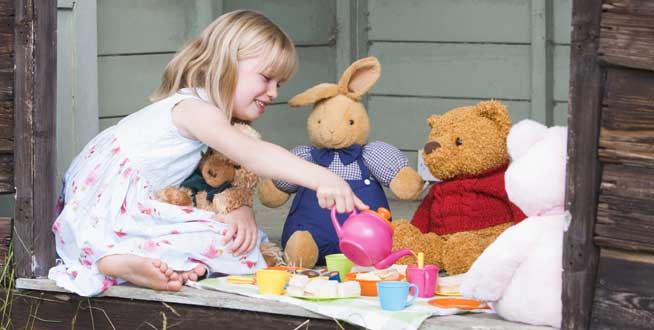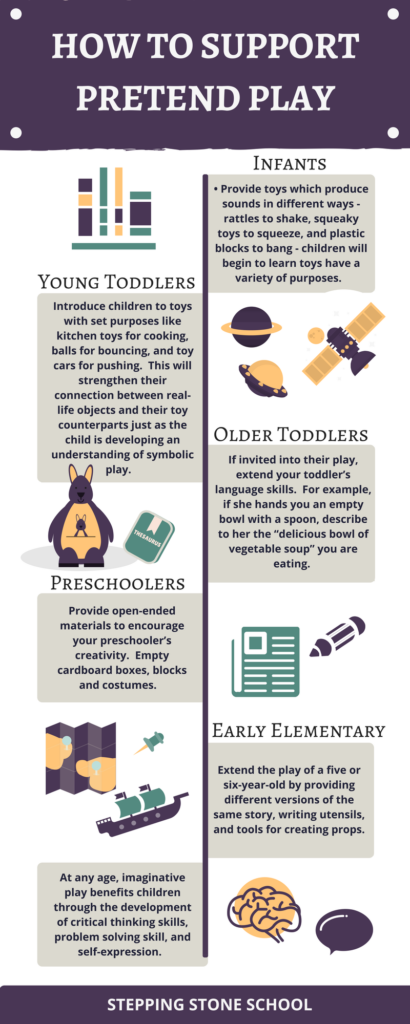Benefits of Play
Two-year-old Ellie set the baby doll in a chair at the table. She balanced a stack of pretend food, a small plate, and a cup and set them on the table before her doll. Ellie took great care to put the food up to the doll’s mouth and hold the cup to his lips. Then, Ellie picked up the baby doll, patted his back and laid him carefully in the doll bed for his nap.
Through her play, my daughter showed me just how well she knows her routine. Ellie demonstrates caring attitudes as she fed her baby doll and gently tucked him into bed. She is making connections between the symbolism of the toys and the sequence of her day.
As children participate in pretend play, critical thinking and problem-solving skills are developed. Sherri Johnson, educational psychologist, states,
“Pretend play is a developmental process that has very specific steps for children.… Pretend or imaginative play is an integral component for the foundation for emotional, intellectual, and social development of all children. Boys and girls progress through these stages of play using common objects, dolls, stuffed toys, and almost anything they can get their hands on to play.” (Johnson, 2013)

Developmental Stages of Pretend Play
Shortly after his first birthday, a child will demonstrate his understanding of how to play with certain toys. He will imitate what he has observed from the environment like putting a toy phone up to his ear, pushing a toy car, or throwing a toy ball. This symbolic play allows him to use his imagination to understand real events in his life.
Between 2 and 3 years, the child demonstrates a certain amount of forethought as she prepares her play. Just as Ellie brought in a small plate and cup, children begin to incorporate items from around the home to bring into their play scenarios. This play becomes increasingly more complex as the child includes planning and sequencing of events.
Once children hit the preschool years, ages 3 to 4, children begin to invite others into their play. They assign roles and talk through the steps throughout the play sequence. They learn to express feelings through their imaginative play by comforting a doll who is scared to go to the doctor or celebrating a stuffed animal’s birthday complete with songs and cheers.
By early elementary age 5 and 6, children participate in true cooperative play. Their play is organized with a given sequence and narrated by the children. Provided with enough time, they create multi-act productions based on a story developed in their imagination. Provided with certain resources they can and often will create their own costumes and props to support their play.
How to Support Pretend Play
As parents, there are number of ways to support children’s imaginative play based on their age (Miller, Church, and Pool, n.d.; Johnson, 2013):
- For Infants: Provide toys which produce sounds in different ways – rattles to shake, squeaky toys to squeeze, and plastic blocks to bang – children will begin to learn toys have a variety of purposes.
- Young Toddlers: Introduce children to toys with set purposes like kitchen toys for cooking, balls for bouncing, and toy cars for pushing. This will strengthen their connection between real-life objects and their toy counterparts just as the child is developing an understanding of symbolic play.
- Older Toddlers: If invited into their play, extend your toddler’s language skills. For example, if she hands you an empty bowl with a spoon, describe to her the “delicious bowl of vegetable soup” you are eating.
- Preschoolers: Provide open-ended materials to encourage your preschooler’s creativity. Empty cardboard boxes, blocks and costumes.
- Early Elementary: Extend the play of a five or six-year-old by providing different versions of the same story, writing utensils, and tools for creating props.
At any age, imaginative play benefits children through the development of critical thinking skills, problem solving skill, and self-expression. Sometimes, stepping back, we will see just how closely our child is watching and learning from their daily routines and experiences.

Resources:
Johnson, S. (2013, Jul 8). Developmental Progression of Pretend Play. Retrieved from http://www.lifestagesinc.com/blog/4557419691/Developmental-Progression-of-Pretend-Play/6090627
Miller, Church, Poole. (n.d.). Ages and Stages: Imagine and Pretend. Retrieved from https://www.scholastic.com/teachers/articles/teaching-content/ages-stages-imagine-pretend/
Snow, K. (n.d.). Research News You Can Use: Pretend Play is Important but Its Role in Learning is Complex. Retrieved from http://www.naeyc.org/content/research-news-pretend-play-is-important